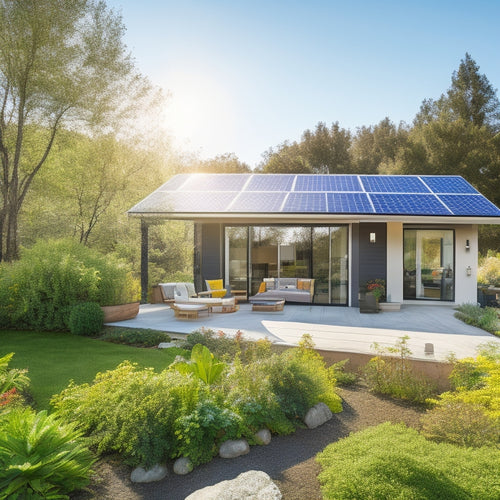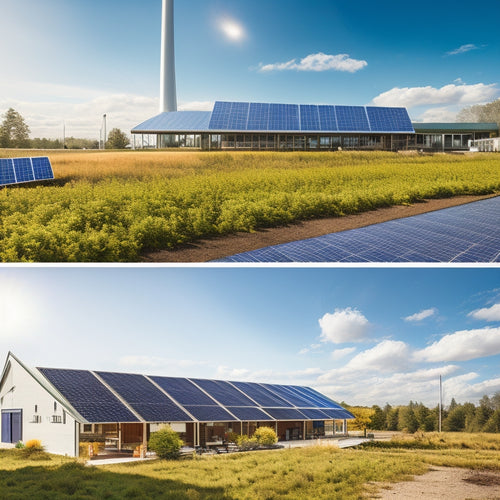
A Beginner's Guide to Commercial Solar System Design and Installation
Share
As you maneuver through the intricacies of commercial solar system design and installation, it is crucial to understand the unique requirements of larger-scale systems, including custom designs, grid integration, and scalability. You'll need to evaluate your energy needs and goals, selecting high-quality equipment that meets your requirements. A well-designed solar array considers site suitability, shading, and ideal panel orientation. From roof and building considerations to electrical and safety standards, permitting, and installation best practices, every detail matters. By grasping these crucial elements, you'll be well on your way to utilizing the full potential of solar energy - and there's still more to uncover about enhancing your system's performance and ROI.
Key Takeaways
- Commercial solar systems require custom designs, considering factors like energy usage patterns, roof size, and orientation for optimal performance.
- High-quality solar panels, inverters, and mounting systems are crucial for efficient energy conversion, maximizing output, and ensuring long-term reliability.
- Accurate energy production forecasting and financial incentives, like tax credits and grants, are essential for optimal system sizing and maximizing return on investment.
- Compliance with electrical and safety standards, such as NEC, IBC, and OSHA regulations, is vital for system safety, operational efficiency, and worker protection.
- Proper installation techniques, routine maintenance, and regular inspections are critical for ensuring optimal performance, longevity, and upkeep of the commercial solar system.
Understanding Commercial Solar Systems
Commercial solar systems are typically larger and more complex than their residential counterparts, frequently requiring custom designs to meet the unique energy demands of a business or organization.
When you invest in a commercial solar system, you'll need to contemplate various factors, including solar incentives and financing options that can help offset the initial cost. Grid integration is also essential, as it enables you to sell excess energy back to the grid and offset your energy bills.
Additionally, you'll want to assess the environmental impact of your system, which can notably reduce your carbon footprint. System scalability is also important, as it allows you to expand your system as your energy needs grow.
Moreover, a commercial solar system can provide energy resilience, guaranteeing that your business remains operational during power outages. You'll also want to evaluate the return on investment, which can be considerable given the advancements in technology.
Furthermore, regulatory compliance is critical, as it guarantees that your system meets local and national standards. Finally, you may want to investigate community solar options, which enable multiple organizations to share the benefits of a single solar array.
Assessing Energy Needs and Goals
You need to understand your energy usage patterns to determine the ideal commercial solar system design for your facility.
This involves analyzing your historical energy consumption data to identify peak demand periods, energy-intensive operations, and opportunities for energy efficiency improvements.
Energy Usage Patterns
Since energy efficiency is a top priority for businesses, evaluating energy needs and goals is an indispensable step in designing a commercial solar system. You need to understand your energy usage patterns to determine the ideal system size and configuration.
Analyzing your energy consumption trends helps identify peak usage times, which are vital in determining the system's capacity. This involves reviewing your past energy bills, monitoring your energy usage, and identifying patterns and anomalies.
You'll want to pinpoint the times of day when energy demand is highest, such as morning startup or mid-afternoon production peaks. This information will help you design a system that meets your energy needs during these important periods.
Additionally, understanding your energy usage patterns will enable you to identify opportunities for energy efficiency improvements, reducing your overall energy consumption and maximizing the benefits of your solar system.
Desired Energy Savings
Most businesses aim to reduce their energy expenses by at least 50% through solar power integration. As you assess your energy needs and goals, it's crucial to determine the desired energy savings from your commercial solar system. This will help you evaluate the system's performance and long-term savings.
To achieve your desired energy savings, consider the following factors:
-
Energy Efficiency: Assess your current energy usage patterns to identify areas of improvement, making sure your solar system is optimized for maximum energy efficiency.
-
Cost Analysis: Evaluate the total cost of ownership, including financing options, tax credits, and incentive programs, to determine the return on investment for your solar system.
-
Environmental Impact: Calculate the reduction in greenhouse gas emissions and carbon footprint, aligning with your company's sustainability goals.
- Utility Rates: Analyze current and projected utility rates to guarantee your solar system provides the desired energy savings and return on investment.
Choosing the Right Equipment
You'll need to select high-quality solar panels that meet your energy requirements and budget.
Additionally, you'll need to choose the right inverters and power optimizers to guarantee efficient energy conversion and monitoring.
When it comes to mounting and tracking systems, you'll want to select options that optimize energy production while withstanding environmental stresses.
Selecting Quality Solar Panels
As you begin designing and installing a commercial solar system, selecting quality solar panels is an essential step that can make or break the entire project. You need to evaluate several critical factors to guarantee you get the most out of your investment.
When selecting solar panels, contemplate the following key factors:
-
Solar panel efficiency: Look for panels with high efficiency ratings to maximize energy production per unit area.
-
Brand reputation and warranty terms: Choose a reputable brand that offers extensive warranty terms, including performance guarantees and extended warranties.
-
Installation compatibility and environmental impact: Verify the panels are compatible with your installation's structural and environmental requirements, and assess the environmental impact of the manufacturing process.
- Cost analysis and technological advancements: Weigh the upfront cost against the long-term benefits, and reflect on the latest technological advancements in panel design and performance testing.
Inverters and Power Optimizers
Your commercial solar system's performance relies heavily on the seamless conversion of DC power from your solar panels to AC power for your building's electrical infrastructure. This conversion process is facilitated by inverters, which come in three primary types: string inverters, microinverters, and power optimizers.
String inverters are the most common, offering a cost-effective solution. Microinverters, on the other hand, provide individual panel optimization, guaranteeing maximum energy harvest. Power optimizers, like DC-DC converters, enhance energy output at the panel level before sending it to a central inverter.
When selecting an inverter, consider factors such as efficiency, reliability, and monitoring capabilities. Look for inverters with high efficiency ratings (>98%) and strong monitoring systems to guarantee peak performance.
Optimizer benefits include enhanced energy production, real-time monitoring, and improved safety. They also enable panel-level monitoring, allowing for swift identification and resolution of issues.
Mounting and Tracking Systems
Optimize your commercial solar system's energy output by selecting the right mounting and tracking equipment. This is a critical component of your system's design, as it directly impacts the amount of energy your panels can generate.
You'll need to decide between fixed racks, solar trackers, or ground mounts, each with its own benefits and drawbacks.
-
Consider the tilt angles and orientation of your panels to maximize energy production, taking into consideration shading analysis and potential obstacles.
-
Weigh the installation costs and structural integrity of different mounting options, ensuring they can withstand wind loads and other environmental factors.
-
Think about maintenance access and aesthetic considerations, as these can impact the overall efficiency and visual appeal of your system.
- Don't overlook the importance of tracking systems, which can increase energy output by up to 45% compared to fixed mounts, but require more complex installation and maintenance.
Designing a Commercial Solar Array
Designing a commercial solar array requires careful evaluation of several factors to guarantee peak energy production and system longevity. You'll need to assess the site's suitability, factoring in elements like shading, roof size, and orientation. A thorough shading analysis will help you identify potential obstacles and enhance your solar array layout.
| Design Consideration | Why It Matters |
|---|---|
| Energy Production Forecasting | Accurate predictions guarantee ideal system sizing and maximize ROI |
| Site Suitability Assessment | Identifies potential site constraints and informs array design |
| Financial Incentives | Maximizes benefits from tax credits, grants, and other incentives |
Beyond these factors, you'll need to reflect on grid integration strategies, environmental impact assessments, and performance monitoring systems to guarantee a seamless and efficient installation. By carefully evaluating these factors, you can design a commercial solar array that meets your energy needs and provides a strong return on investment. Remember, a well-designed solar array is critical to achieving peak energy production and system longevity.
Roof and Building Considerations
Structural integrity plays an essential role in supporting a commercial solar array, making roof and building considerations a vital aspect of the design process. As you design your commercial solar system, you'll need to assess the condition and suitability of your building's roof and structure to guarantee they can support the weight and stress of the solar array.
-
Roof materials: You'll need to evaluate the type and condition of your roof materials, such as asphalt shingles, metal, or membrane roofing, to determine their compatibility with solar panels.
-
Building orientation: The orientation of your building can impact the performance of your solar array. You'll need to take into account the direction your roof faces and how it will affect energy production.
-
Roof size and layout: You'll need to assess the size and layout of your roof to determine the best placement of solar panels and guarantee they don't obstruct ventilation systems, skylights, or other features.
- Structural reinforcements: You may need to add structural reinforcements to your building to support the weight of the solar array, particularly if your roof is old or has been damaged.
Electrical and Safety Standards
Three key electrical and safety standards must be met when installing a commercial solar system: the National Electric Code (NEC), the International Building Code (IBC), and the Occupational Safety and Health Administration (OSHA) regulations.
You'll need to guarantee regulatory compliance with these standards to avoid costly rework and potential safety hazards.
Conducting regular safety audits will help you identify potential risks and implement measures for risk management. Adhering to electrical codes and installation guidelines will assure that your system is installed correctly and efficiently.
Make certain all equipment is certified and meets the necessary standards.
Proper worker training is also essential to guarantee that your team understands the installation process and can handle the equipment safely.
Finally, implement a system monitoring plan to verify that your solar system is operating at ideal levels and identify any potential issues before they become major problems.
Permitting and Inspection Process
You've guaranteed your commercial solar system meets electrical and safety standards, now it's time to obtain the necessary permits and pass inspections.
This vital step confirms your system complies with local regulations, avoiding costly rework or even system shutdown.
To maneuver the permitting process, you'll need to:
- Submit permit applications, including detailed system designs and specifications
- Meet zoning requirements, verifying your system doesn't encroach on neighboring properties or violate local land-use laws
- Conduct environmental assessments, identifying potential ecological impacts and mitigating measures
- Coordinate with local authorities to schedule inspections, adhering to strict inspection timelines and code compliance standards
Installation and Maintenance Best Practices
A well-executed installation is vital to a commercial solar system's performance and longevity. You must guarantee that your installation team follows industry-standard installation techniques to minimize errors and optimize energy production. This includes properly securing panels to the roof, connecting electrical components, and testing the system for faults.
Once installed, regular maintenance is imperative to maintain the system's efficiency and extend its lifespan. You should establish a routine maintenance schedule that includes quarterly inspections, annual cleaning, and bi-annual performance monitoring. This will help identify and address potential issues before they become major problems.
Additionally, keep accurate records of maintenance activities, including dates, tasks performed, and any repairs made. This will enable you to track the system's performance over time and make informed decisions about future maintenance and upgrades.
Frequently Asked Questions
Can I Install a Commercial Solar System on a Leased Property?
You can install a commercial solar system on a leased property, but you'll need to secure permission from the property owner and review lease agreements to guarantee compatibility, as they may impact system ownership and maintenance responsibilities.
Are There Any Tax Incentives for Commercial Solar System Owners?
You'll be pleased to know that, as a commercial solar system owner, you're eligible for tax benefits like the Solar Investment Tax Credit (ITC), which allows you to claim up to 26% of your system's cost as a credit against your tax liability.
Can I Use a Commercial Solar System to Power Electric Vehicle Charging?
As you accelerate into the future, you're probably wondering if your commercial solar system can fuel your electric vehicle's expedition. The answer is yes! You can utilize the power of solar charging to energize your EVs, enhancing energy efficiency and reducing your carbon footprint.
How Do I Handle Snow and Ice on Commercial Solar Panels?
You'll need to prioritize snow removal and ice management to maintain your commercial solar panels' efficiency; consider investing in automated snow removal systems or partnering with a professional maintenance team to guarantee peak performance.
Can I Add Energy Storage to an Existing Commercial Solar System?
You can add energy storage to an existing commercial solar system, but you'll need to manage integration challenges and weigh various energy storage options, considering factors like system size, battery type, and inverter compatibility to guarantee seamless operation.
Conclusion
You've now acquired expertise in the fundamentals of commercial solar system design and installation. By understanding energy needs, selecting the right equipment, and designing a solar array that meets electrical and safety standards, you're ready to utilize the power of the sun. With permitting and inspection complete, your installation is set to generate clean energy and significant savings. As you maintain your system, remember to monitor performance, address issues promptly, and optimize energy production to maximize your return on investment.
Related Posts
-

Green Home Improvements Using Solar Power
Investing in solar power alters your home into a sustainable haven while slashing energy costs. You can greatly reduc...
-

Eco-Friendly Home Design Ideas for Beginners
If you're starting your eco-friendly home design expedition, focus on sustainable materials like recycled wood or rec...
-

Off-Grid Solar Solutions for Eco-Conscious Businesses
Off-grid solar solutions offer you a path to both sustainability and substantial cost savings. By adopting these syst...


